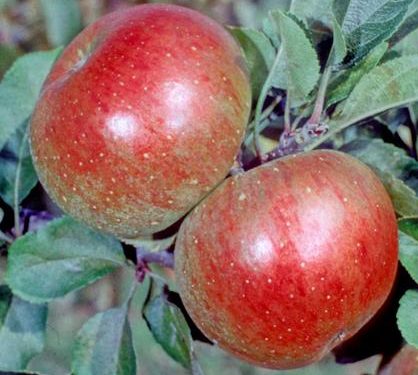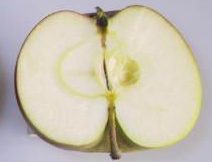PARENTAGE OF LORD LAMBOURNE
The parents are James Grieve and Worcester Pearmain. This variety dates back to 1907 and originates from Bedford.
APPEARANCE AND TASTE OF LORD LAMBOURNE APPLES
A very handsome looking apple. Although no longer produced commercially, when Lord Lambourne apples are sold at local markets this is the variety which customers often choose based on looks alone.
The apples are medium sized with a yellow background colour streaked red especially on the sun facing side. The flesh is crunchy and full of juice. The flavour is a good balance of acidity and sweetness, sweetening more as it reaches peak ripeness.
If kept for more than a couple of weeks in storage the crunchiness begins to disappear but the flavour and aroma remains. The apples stay on the tree longer than most, increasing the time of use to a couple of months.

GROWING LORD LAMBOURNE APPLES IN THE UK
Lord Lambourne does well in almost all areas of the UK. Pest and disease resistance is above average and if scab is a problem in your garden then Lord Lambourne has a high resistance level and is likely to be affected only in the wettest growing years. Fruit is produced in almost all years and lots of it. The blossom is particularly attractive.
This variety is partially self fertile and will produce a good crop of apples even when grown on it’s own. It will benefit from nearby suitable pollination partners nearby especially in less favourable years. It produces flowers a couple of weeks earlier than the average apple however the blossom is resistant to the odd frost or two.
All the basic rules for growing apple trees apply to Lord Lambourne although we would recommend only pruning when absolutely necessary. This variety is not one of the quickest growers and it is best to let it settle down for three or four years. We suggest growing it on MM106 rootstock in average soil and weather conditions.
PRUNING A LORD LAMBOURNE APPLE TREE
Lord Lambourne produces fruit buds in the most common way, as a spur bearer. See here for more advice on pruning apple trees.
In some years Lord Lambourne can over crop so be ready to support any heavily laden, long branches and remember to prune them back during the winter. The other alternative is to thin about a third to half the fruits in mid June. Much will depend on the growing conditions in your garden / allotment.

FLOWERING AND HARVEST TIMES:
The average flowering time (optimum time for pollination) and date when fruits are ripe for harvest in the UK for the Lord Lambourne apple tree are set out below. If you have set your home town we can give you a more accurate estimate, if you have not set your home town (do it now by clicking here) the dates below will be the average for the UK.
Your town has not been set, the average main flowering time for Lord Lambourne
in the UK is the first week of May. Fruit will be ready for harvesting in the third week of September.
Click here if you want to set the dates to your home town.
Flowering and fruit picking dates vary according to the weather in any particular growing season so the above dates may well change slightly from one year to the next. The flowering date above is when the apple tree produces the maximum number of blossoms, it will also produce blossom, although less, a week or two either side of the date given.
BUYING LORD LAMBOURNE APPLE TREES
Lord Lambourne apple trees are available to buy from a few garden centres, most plant nurseries and via websites in the UK. One online plants nursery we can recommend who supply this variety is Ashridge Trees.
In common with most other apple trees buying online from a garden centre looks to be the most expensive option although picking up a tree yourself from your local garden centre will give better prices.
Wait until November onwards and bare-rooted trees will be in stock at much cheaper prices compared to pot grown ones.
Remember that all apple trees need a stake to support them for the first couple of years and some require staking for life. So if you haven’t got a stake and a tie for your new tree then buy one when you order the tree for convenience.
COMMON POLLINATION PARTNERS FOR LORD LAMBOURNE
Lord Lambourne is in pollination group 2. It is self-fertile but in poor years it may benefit from a pollination partner. Suitable pollination varieties include the following:
- Alkmene – pollination group 2, self-sterile, eater
- Arthur Turner – pollination group 3, self-sterile, cooker
- Beauty of Bath – pollination group 2, self-sterile, eater
- Bountiful – pollination group 3, self-sterile, cooker
- Charles Ross – pollination group 3, partially self-fertile, cooker and eater
- Court of Wick – pollination group 3, self-sterile, eater and cooker
- Cox’s Orange Pippin – pollination group 3, partially self-fertile (see here), eater and cooker
- Devonshire Quarrenden – pollination group 2, partially self-fertile, cooker
- Discovery – pollination group 3, self-sterile, eating and cider
- Egremont Russet – pollination group 2, partially self-fertile, eater and cooker
- Fiesta – pollination group 3, partially self-fertile, eater
- Granny Smith – pollination group 3, self fertile, eater and cooker
- Greensleeves – pollination group 2, self-fertile, eater, cooker, juice
- Grenadier – pollination group 3, partially self-fertile, cooker
- Howgate Wonder – pollination group 3, partially self-fertile, cooker and eater
- Idared – pollination group 2, self-sterile, eater, cooker
- Katy – pollination group 3, self-sterile, eater
- Kidds Orange Red – pollination group 3, self-sterile, eater
- Peasgoods Nonsuch – pollination group 3, partially self-fertile, cooker
- Red Windsor – pollination group 2, self-fertile, eater
- Reverend W Wilks – pollination group 2, self-fertile, cooker
- Scrumptious – pollination group 3, self-fertile, eater
- Sops in Wine – pollination group 3, self-sterile, juicer
- Spartan – pollination group 3, self-fertile, eater
- Sunset – pollination group 3, self-fertile, eater and cooker
- Winston – pollination group 4, self-fertile, eater
The full list of apple tree varieties which we have reviewed is listed below. Select any one of them and then click the “More Information” button to be taken to the in depth review:
SUMMARY OF LORD LAMBOURNE APPLE TREES
USE: Eating, cooking, juicing
SKIN COLOUR / TEXTURE: Yellow-orange background with red streaks
FLESH COLOUR: Creamy white
TASTE AND TEXTURE: Slightly acidic, full flavoured, crisp. Sweeter if left on the tree to fruit fall
FRUIT SIZE: Average
STORAGE: One month
SUITABILITY FOR CORDON / ESPALIER GROWTH: Yes
TREE SIZE: Slightly smaller than average
REGULARITY OF CROPPING: Extremely reliable cropper
POLLINATION: Partially self-fertile. Pollination Group 2 (see here for suitable partners)
AWARDS: Awarded a Royal Horticultural Society Award of Garden Merit in 1993, reconfirmed in 2013.
SPECIAL FEATURES: Very reliable cropper, good disease resistance, tasty apples, good scab resistance.
(this page contains public sector information licensed under the Open Government Licence v1.0.)
Rootstocks and Size
Guide to Planting
Care Plan
Pruning Apple Trees
Harvest and Storage
Pests and Disease
Pollination Groups
LORD LAMBOURNE APPLE TREE
Lord Lambourne is far better than average in many respects compared to other apple trees but it does excel in being an excellent all rounder. This is a very useful attribute for those who have only room for one or two apple trees in their garden.
For apple growers who have large orchards, they might not rate this variety as highly as it truly deserves. It does however excel in one extremely useful way for those who have very limited ability to store apples. The fruits stay on the tree, in excellent shape, for a month or so. Harvest of fruit, straight from the tree, is normally possible for at least four weeks.